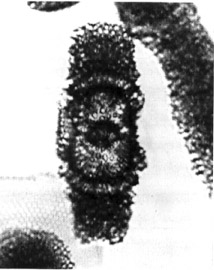 Diartus
petterssoni (Riedel and Sanfilippo)
Diartus
petterssoni (Riedel and Sanfilippo) Diartus
petterssoni (Riedel and Sanfilippo)
Diartus
petterssoni (Riedel and Sanfilippo)Cannartus(?) petterssoni conditional manuscript name proposed in Riedel and Funnell, 1964, p.310; Riedel and Sanfilippo, 1970, p.520, pl.14, fig.3
Diartus petterssoni (Riedel and Sanfilippo), Sanfilippo and Riedel, 1980, p.1010
Cortical shell rather thick-walled, approximately cylindrical (sometimes bulged at the equator), with pronounced protuberances surrounding each end of the cortical shell. Pores of the cortical shell circular or subcircular, smaller near the equator. Two medullary shells, of which the outer is commonly spherical, sometimes lenticular. Very broad spongy columns (in some specimens divided into narrow parallel zones) are separated from the cortical shell by a narrow clearer zone: the distal margin of this clearer zone is commonly at the end of the protuberances (Riedel and Sanfilippo, 1970).
Length of spongy columns 25-100 µm (commonly about 50 µm); their median breadth 50-85 µm. Length of cortical shell 80-100 µm; its maximum breadth (including protuberances) 75-95 µm. Breadth of outer medullary shell 25-40 µm (Riedel and Sanfilippo, 1970).
The most characteristic features are the broad, spongy columns at the ends of the subcylindrical to subspherical cortical shell, medullary shell tending to be spherical, and, in most specimens, pronounced tubercles in a single row at each end of the cortical shell. Closely related species are Didymocyrtis laticonus, which has tubercles more evenly distributed over the cortical shell, and Diartus hughesi, in which the skeletal structures at each end of the cortical shell are multiple concentric caps rather than spongy columns (Sanfilippo et al., 1985).
The tubercles on the cortical shel1 are variably developed--in some specimens, practically absent. The cortical shell is usually elongate, but, especially in the later part of the range of the species, it is subspherical in some specimens (Cannartus sp. aff. C. petterssoni in Holdsworth, 1975, p.519): the fact that the cortical shell varies continuously in length from 115 to 80 µm leads us not to separate the two as separate taxa. Some specimens show concentric zonation (like the caps of Diartus hughesi) in the proximal parts of their spongy columns. The medullary shell typically presents a circular outline, but in some specimens it is compressed as in most other artiscins (Sanfilippo et al., 1985).
A late middle Miocene species. Specimens from different parts of its geographic range (DSDP Sites 66, 71, 77, 206, 214, 216 and 223, and Experimental Mohole) show no noticeable morphologic differences. None were found at latitudes higher than about 45° (DSDP Sites 281 and 341). The record of this species at Site 139 (Petrushevskaya and Kozlova, 1972, pl.12, fig.5) is based on specimens that we would identify as Didymocyrtis laticonus (Sanfilippo et al., 1985).
The morphotypic first appearance of this species defines the lower limit of the Diartus petterssoni Zone. The evolutionary transition of this species to Diartus hughesi marks the boundary between the Diartus petterssoni Zone and the Didymocyrtis antepenultima Zone.
This species originated from Didymocyrtis laticonus, and evolved into Diartus hughesi.
Additional illustrations can be found in Riedel and Sanfilippo, 1971, pl.1C, figs.15-16, 19-20; Johnson, 1974, pl.7, figs.6-7.